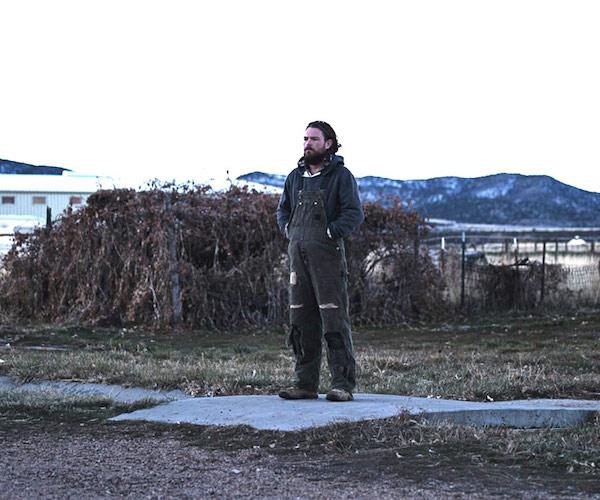Film Review: “The Killing of Two Lovers” — Lives of Quiet Desperation
By Tim Jackson
We are subtly drawn into the world of director Robert Machoian’s characters and their emotional honesty.
The Killing of Two Lovers, directed by Robert Machoian. Streaming on Amazon Prime

Clayne Crawford in a scene from The Killing of Two Lovers.
The Killing of Two Lovers begins with a disheveled husband aiming a pistol at a sleeping couple. Anton Chekhov’s famous instruction is “If in Act One you have a pistol hanging on the wall, then it must fire in the last act.” Will that be the case in writer/director Robert Machoian’s first feature? Learning the answer generates most of the film’s suspense over the next 85 minutes. Is the title real or metaphoric?
The disturbing opening shot is ambiguous: the audience is asked to decipher whether it was a flashback, a fantasy, or a vision of impending misfortune. Everyday moments unfold in long tense takes or in tightly framed close-ups — the outcomes of these confrontations are uncertain.
The narrative revolves around a couple living in a sparsely populated western town, the unnamed Kanosh, Utah.) David (Clayne Crawford) and Nikki (Sepideh Moafi) married young and now find themselves in conflict as the pressures of reality grind down their initial illusions of romance. She hopes someday to go to law school; David patches together an income with odd jobs. They have agreed to a trial separation with an agreement they can see other people, but that arrangement is not easy when you are dealing with four kids and live in a small town. David desperately wants the family to stay intact, but Nikki has taken a lover (Chris Coy) who brazenly refers to himself as her “boyfriend.” He’s physically less intimidating than David — he is the matador to the other’s bullish ego.
Crawford is an actor who can project, with ease, an air of restrained volatility. His performance captures the despair of a man worn down by the world, battling traumatic blows to his pride as a father and breadwinner. David is gloomy, short-tempered, and has a chip on his shoulder. His earnest attempts at acting with reason and understanding are tinctured by jealousy. Demeaning odd jobs do little to bolster his sense of self-worth, so he is as much at odds with himself as he is with his marriage. After efforts at reconciliation fail, the couple’s oldest daughter resents that the adults can’t get their act together.
Kanosh, with its towering mountains and open ranges, sat, in the late ’50s and early ’60s, in proximity to the government’s atomic testing, which sent the population scurrying away. That reality, while not mentioned outright, is made tangible by cinematographer Oscar Ignacio Jiménez, who makes powerful use of the area’s expansive, unpopulated landscapes, a stark contrast to the presence of claustrophobic, undistinguished lives. The American West once generated a mythic power — it was a place of infinite potential, where one went to fulfill a dream or reinvent a life. Now it has given way to a different reality, one defined by limits — quiet frustration and, too often, defeat.
Several recent small budget, social realist films have looked at working class malaise, but they have offered hopeful conclusions. Chloé Zhao’s Nomadland ends up celebrating an existence that many of us would find depressing. In Miranda de Pencier’s The Grizzlies, a disillusioned group of Inuit student lacrosse players manage to find triumph in defeat. Similarly, in Lee Isaac Chung’s exultant Minari, a Korean family starts a farm in ’80s Arkansas and makes the best of daunting challenges. However, Kelly Reichardt’s First Cow, doesn’t see the American West as a site harboring grand possibility but a place of racism, violence, death. The Killing of Two Lovers is somewhere in between: the violence is certainly lurking there, but also a possibility of understanding and reconciliation. The taming of the wilderness doesn’t have to do with violence or domination — it is about understanding and compromise. It’s the resolution we hope for in Machoian’s drama — though it may be too much to ask for.
The Killing of Two Lovers was shot on a shoestring budget of just over $30,000 and arrives at a time when blockbusters have taken a back seat to more intimate films. After four years of political chaos and a pandemic that has tested everybody’s patience moviegoers may be impatient with fantasy of the superhero variety. They would be better served by appreciating films like this, compassionate stories in which common people struggle to turn around lives bent by bad luck and misfortune.
Tim Jackson was an assistant professor of Digital Film and Video for 20 years. His music career in Boston began in the 1970s and includes some 20 groups, recordings, national and international tours, and contributions to film soundtracks. He studied theater and English as an undergraduate, and has also has worked helter skelter as an actor and member of SAG and AFTRA since the 1980s. He has directed three feature documentaries: Chaos and Order: Making American Theater about the American Repertory Theater; Radical Jesters, which profiles the practices of 11 interventionist artists and agit-prop performance groups; When Things Go Wrong: The Robin Lane Story, and the short film The American Gurner. He is a member of the Boston Society of Film Critics. You can read more of his work on his blog.
